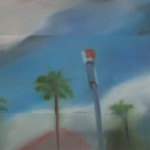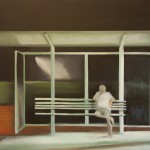Edition of 1000
In Werner’s images of people in the urban environment there are often traces of illustration that come from his keen interest in attention to detail that is not as evident in his more panoramic and epic paintings. This illustrative quality can be seen to good example in the group of pencil drawings made in preparation for many of the paintings in this exhibition.
In these most recent paintings Werner continues the theme of the contemporary urban sublime by taking ordinary, commonplace and familiar scenes and through shifting focus or the freezing of a moment in time presents them anew. In Your suburb 1 and 2-Ipswich Road the everyday drive, the vista of roofs, palms and recognisable fast food outlet signage is transformed through the use of altered focus within the picture frame into a slipping vision of the ever changing – still the same vista.
It is in these pictures that Werner also picks up on another prevalent theme of modern and contemporary western art, the loneliness and isolation of the city, portrayed with such lyricism in the work of the great American Painter Edward Hopper. This can been seen in Man at a Bus Stop-Brunswick Street where the solitary nature of the indistinct figure is only heightened by the surrounding cool night air punctuated by the illuminated glow of the shelter advertising panel. The influence of Edward Hopper is particularly pervasive in Stairs 1 and 2-Coronation Drive where Werner echoes many of Hoppers paintings of the stoops and steps of Brownstone townhouses commonplace in cities like Boston and New York.

However, Werner’s interest in the natural environment intertwines with that of the suburban in works such as Trees 1and 2-Riverside Drive in which a stand of trees, perhaps representing natures increasing isolation within the urban environment, along the riverside drive in West End on a blustery and brooding evening is frozen and transformed by the illumination of a sudden flash of light.
